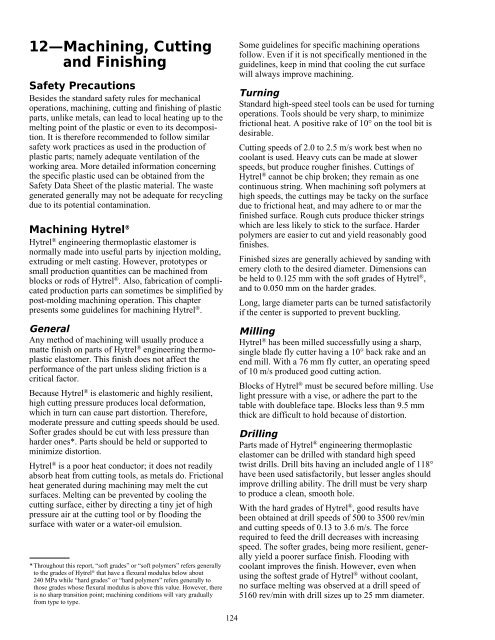General Design Principles for DuPont Engineering Polymers - Module
General Design Principles for DuPont Engineering Polymers - Module
General Design Principles for DuPont Engineering Polymers - Module
Create successful ePaper yourself
Turn your PDF publications into a flip-book with our unique Google optimized e-Paper software.
12—Machining, Cutting<br />
and Finishing<br />
Safety Precautions<br />
Besides the standard safety rules <strong>for</strong> mechanical<br />
operations, machining, cutting and finishing of plastic<br />
parts, unlike metals, can lead to local heating up to the<br />
melting point of the plastic or even to its decomposition.<br />
It is there<strong>for</strong>e recommended to follow similar<br />
safety work practices as used in the production of<br />
plastic parts; namely adequate ventilation of the<br />
working area. More detailed in<strong>for</strong>mation concerning<br />
the specific plastic used can be obtained from the<br />
Safety Data Sheet of the plastic material. The waste<br />
generated generally may not be adequate <strong>for</strong> recycling<br />
due to its potential contamination.<br />
Machining Hytrel ®<br />
Hytrel ® engineering thermoplastic elastomer is<br />
normally made into useful parts by injection molding,<br />
extruding or melt casting. However, prototypes or<br />
small production quantities can be machined from<br />
blocks or rods of Hytrel ® . Also, fabrication of complicated<br />
production parts can sometimes be simplified by<br />
post-molding machining operation. This chapter<br />
presents some guidelines <strong>for</strong> machining Hytrel ® .<br />
<strong>General</strong><br />
Any method of machining will usually produce a<br />
matte finish on parts of Hytrel ® engineering thermoplastic<br />
elastomer. This finish does not affect the<br />
per<strong>for</strong>mance of the part unless sliding friction is a<br />
critical factor.<br />
Because Hytrel ® is elastomeric and highly resilient,<br />
high cutting pressure produces local de<strong>for</strong>mation,<br />
which in turn can cause part distortion. There<strong>for</strong>e,<br />
moderate pressure and cutting speeds should be used.<br />
Softer grades should be cut with less pressure than<br />
harder ones*. Parts should be held or supported to<br />
minimize distortion.<br />
Hytrel ® is a poor heat conductor; it does not readily<br />
absorb heat from cutting tools, as metals do. Frictional<br />
heat generated during machining may melt the cut<br />
surfaces. Melting can be prevented by cooling the<br />
cutting surface, either by directing a tiny jet of high<br />
pressure air at the cutting tool or by flooding the<br />
surface with water or a water-oil emulsion.<br />
* Throughout this report, “soft grades” or “soft polymers” refers generally<br />
to the grades of Hytrel ® that have a flexural modulus below about<br />
240 MPa while “hard grades” or “hard polymers” refers generally to<br />
those grades whose flexural modulus is above this value. However, there<br />
is no sharp transition point; machining conditions will vary gradually<br />
from type to type.<br />
124<br />
Some guidelines <strong>for</strong> specific machining operations<br />
follow. Even if it is not specifically mentioned in the<br />
guidelines, keep in mind that cooling the cut surface<br />
will always improve machining.<br />
Turning<br />
Standard high-speed steel tools can be used <strong>for</strong> turning<br />
operations. Tools should be very sharp, to minimize<br />
frictional heat. A positive rake of 10° on the tool bit is<br />
desirable.<br />
Cutting speeds of 2.0 to 2.5 m/s work best when no<br />
coolant is used. Heavy cuts can be made at slower<br />
speeds, but produce rougher finishes. Cuttings of<br />
Hytrel ® cannot be chip broken; they remain as one<br />
continuous string. When machining soft polymers at<br />
high speeds, the cuttings may be tacky on the surface<br />
due to frictional heat, and may adhere to or mar the<br />
finished surface. Rough cuts produce thicker strings<br />
which are less likely to stick to the surface. Harder<br />
polymers are easier to cut and yield reasonably good<br />
finishes.<br />
Finished sizes are generally achieved by sanding with<br />
emery cloth to the desired diameter. Dimensions can<br />
be held to 0.125 mm with the soft grades of Hytrel ® ,<br />
and to 0.050 mm on the harder grades.<br />
Long, large diameter parts can be turned satisfactorily<br />
if the center is supported to prevent buckling.<br />
Milling<br />
Hytrel ® has been milled successfully using a sharp,<br />
single blade fly cutter having a 10° back rake and an<br />
end mill. With a 76 mm fly cutter, an operating speed<br />
of 10 m/s produced good cutting action.<br />
Blocks of Hytrel ® must be secured be<strong>for</strong>e milling. Use<br />
light pressure with a vise, or adhere the part to the<br />
table with doubleface tape. Blocks less than 9.5 mm<br />
thick are difficult to hold because of distortion.<br />
Drilling<br />
Parts made of Hytrel ® engineering thermoplastic<br />
elastomer can be drilled with standard high speed<br />
twist drills. Drill bits having an included angle of 118°<br />
have been used satisfactorily, but lesser angles should<br />
improve drilling ability. The drill must be very sharp<br />
to produce a clean, smooth hole.<br />
With the hard grades of Hytrel ® , good results have<br />
been obtained at drill speeds of 500 to 3500 rev/min<br />
and cutting speeds of 0.13 to 3.6 m/s. The <strong>for</strong>ce<br />
required to feed the drill decreases with increasing<br />
speed. The softer grades, being more resilient, generally<br />
yield a poorer surface finish. Flooding with<br />
coolant improves the finish. However, even when<br />
using the softest grade of Hytrel ® without coolant,<br />
no surface melting was observed at a drill speed of<br />
5160 rev/min with drill sizes up to 25 mm diameter.

















